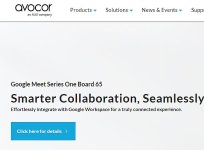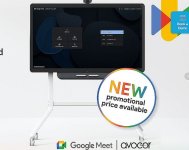Recently, corporate announcements revealed that AUO Display Plus (ADP), a subsidiary of Taiwan's leading display panel manufacturer AU Optronics (AUO), has acquired the emerging U.S. interactive display brand Avocor. This move is expected to significantly impact AUO's vertical integration strategy and the global commercial display market, particularly in the interactive large-screen segment.
Panel Giant Expands into Branded End Markets
AUO is one of the world's top display panel manufacturers and a pioneer in large-size LCD panels. According to RUNTO, global shipments of large-size LCD TV panels reached 237 million units in 2024, with AUO accounting for 16.4 million (6.9% market share). While AUO ranks in the second tier, it remains a globally influential player in the highly consolidated panel industry. [Image1]
Avocor specializes in large interactive displays for education, corporate collaboration, and commercial applications. Its product lineup spans 27 to 138 inches, emphasizing versatility (e.g., interactive education, remote meetings, digital signage) and integrated technologies (touch, video conferencing, cloud management). Key offerings include LED direct-view all-in-ones, 21:9 ultrawide screens, and 100-inch+ interactive displays. The company grew rapidly during the pandemic-driven surge in remote work and education demand.
The acquisition marks AUO's push into the branded commercial display space, creating vertical synergy. RUNTO's quarterly report shows AUO’s interactive flat panel shipments grew 18.1% in 2024, lifting its market share to 9.3%—a 1.7-point annual increase.
Notably, AUO’s share in interactive panels surpasses its TV panel presence, reflecting its focus on high-margin niches like interactive displays and automotive screens. This aligns with its strategy to avoid cutthroat competition in mass-market segments.
For instance, Sigmaintell data shows AUO shipped 24.4 million automotive displays in 2024 (10% global share), ranking third. Its medical display division also leads globally, with 20% growth projected for 2024. Vertical markets now contribute 17% of AUO’s revenue.
Beyond niche expansion, AUO is aggressively pursuing vertical integration. In April 2024, it acquired Germany’s BHTC for €600 million (~$650 million) to bolster automotive HMI and climate control solutions.
Chairman Paul Peng has stated that non-panel businesses should exceed 50% of revenue by 2027, reducing reliance on cyclical panel sales. The Avocor deal exemplifies this shift toward high-growth, high-margin segments.
Can AUO Reshape the Global Interactive Display Race?
While panel-to-brand integration is common (e.g., BOE, TCL CSOT, Samsung), Taiwan’s AUO and Innolux long resisted this trend—making AUO’s pivot noteworthy. [Image2]
Analysts note AUO’s retreat from mainstream panel battles (e.g., lagging in OLED and Gen 10.5/11 fabs) reflects strategic repositioning. Its successes in automotive, medical, and interactive displays contrast with recent divestments, including selling filter plants to Micron and facilities to VIS.
The Avocor merger isn’t a “powerhouse alliance” but could still disrupt the interactive display sector. AUO’s panel resources may accelerate Avocor’s scale, while Avocor’s U.S. foothold—the world’s second-largest market—could reshape North American supply dynamics, especially amid rising trade barriers.
Globally, Avocor may also gain traction in Europe and allied markets. AUO likely aims to build an interactive display platform for smart business/education solutions—a space currently led by Chinese innovators facing overseas expansion pressures.
However, AUO now faces entrenched rivals: panel peers (BOE), electronics giants (Samsung), education specialists (ViewSonic’s Seewo), and TV-turned-commercial brands (Hisense). While niche, this segment is fiercely competitive with frequent price wars, not a “blue ocean.” Future growth may hinge on emerging markets, intensifying cost pressures.
In summary, the deal advances AUO’s vertical strategy. Whether Avocor can thrive under AUO—leveraging panel strengths while battling entrenched competitors—will determine its impact on the commercial display landscape.
Panel Giant Expands into Branded End Markets
AUO is one of the world's top display panel manufacturers and a pioneer in large-size LCD panels. According to RUNTO, global shipments of large-size LCD TV panels reached 237 million units in 2024, with AUO accounting for 16.4 million (6.9% market share). While AUO ranks in the second tier, it remains a globally influential player in the highly consolidated panel industry. [Image1]
Avocor specializes in large interactive displays for education, corporate collaboration, and commercial applications. Its product lineup spans 27 to 138 inches, emphasizing versatility (e.g., interactive education, remote meetings, digital signage) and integrated technologies (touch, video conferencing, cloud management). Key offerings include LED direct-view all-in-ones, 21:9 ultrawide screens, and 100-inch+ interactive displays. The company grew rapidly during the pandemic-driven surge in remote work and education demand.
The acquisition marks AUO's push into the branded commercial display space, creating vertical synergy. RUNTO's quarterly report shows AUO’s interactive flat panel shipments grew 18.1% in 2024, lifting its market share to 9.3%—a 1.7-point annual increase.
Notably, AUO’s share in interactive panels surpasses its TV panel presence, reflecting its focus on high-margin niches like interactive displays and automotive screens. This aligns with its strategy to avoid cutthroat competition in mass-market segments.
For instance, Sigmaintell data shows AUO shipped 24.4 million automotive displays in 2024 (10% global share), ranking third. Its medical display division also leads globally, with 20% growth projected for 2024. Vertical markets now contribute 17% of AUO’s revenue.
Beyond niche expansion, AUO is aggressively pursuing vertical integration. In April 2024, it acquired Germany’s BHTC for €600 million (~$650 million) to bolster automotive HMI and climate control solutions.
Chairman Paul Peng has stated that non-panel businesses should exceed 50% of revenue by 2027, reducing reliance on cyclical panel sales. The Avocor deal exemplifies this shift toward high-growth, high-margin segments.
Can AUO Reshape the Global Interactive Display Race?
While panel-to-brand integration is common (e.g., BOE, TCL CSOT, Samsung), Taiwan’s AUO and Innolux long resisted this trend—making AUO’s pivot noteworthy. [Image2]
Analysts note AUO’s retreat from mainstream panel battles (e.g., lagging in OLED and Gen 10.5/11 fabs) reflects strategic repositioning. Its successes in automotive, medical, and interactive displays contrast with recent divestments, including selling filter plants to Micron and facilities to VIS.
The Avocor merger isn’t a “powerhouse alliance” but could still disrupt the interactive display sector. AUO’s panel resources may accelerate Avocor’s scale, while Avocor’s U.S. foothold—the world’s second-largest market—could reshape North American supply dynamics, especially amid rising trade barriers.
Globally, Avocor may also gain traction in Europe and allied markets. AUO likely aims to build an interactive display platform for smart business/education solutions—a space currently led by Chinese innovators facing overseas expansion pressures.
However, AUO now faces entrenched rivals: panel peers (BOE), electronics giants (Samsung), education specialists (ViewSonic’s Seewo), and TV-turned-commercial brands (Hisense). While niche, this segment is fiercely competitive with frequent price wars, not a “blue ocean.” Future growth may hinge on emerging markets, intensifying cost pressures.
In summary, the deal advances AUO’s vertical strategy. Whether Avocor can thrive under AUO—leveraging panel strengths while battling entrenched competitors—will determine its impact on the commercial display landscape.





